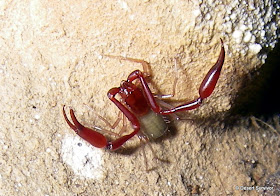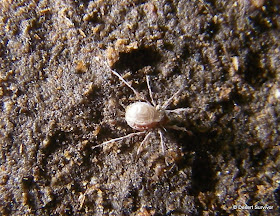I've been lucky to go on some caving trips lately, often with a biological focus, so I couldn't resist testing the limits of my cave point-and-shoot. Above and below are a pseudoscorpion, Microcreagris grandis Muchmore. They're the top of the food chain in many of the area caves.
And they're only about a half-inch to an inch long. Such an ecosystem, where the top predator is smaller than the size of a quarter!
Deb and Gerry helped me download data loggers along with place bait. They hadn't done much caving but were amazingly agile and moved without any problems.
This tiny spider was really, really tiny, like about 2 mm long.
My caving group after the cave trip. Notice how clean they all look. We visited a clean cave. (Spoiler: muddy cave to come.)
This is a dipluran, and we may never know the species unless someone decides to become a dipluran expert and take on some work describing new diplurans! (Young readers, please take note of this. If you're the only dipluran expert in the world, you could get a lot of work heading your way.)
Notice what the dipluran is on--wet, gooey mud.
If you're wondering if this is a different cave, you're right!
The above photo really isn't of nothing. In fact, there are five cave critters captured--a mama and four little babies. The babies are less than 1 mm long (very sorry for mixing English and metric systems, I end up using both for work). They are Arrhopalites springtails, and I watched them jumping on the surface of the water.
Those Arrhopalites springtails were on the top of the water, but at the bottom of the little puddle was a white planaria. Maybe we can find someone to identify it.
Anyone know any planaria experts?
It would take a special kind of person to be a planaria expert.
Just saying.
Phew, on to something almost warm and cuddly. At least it's bigger than two inches long and easily seen. This is a harvestman, this species only found in caves, and a relative of Daddy-long legs. It belongs to the Opilionid family, which means it is a cousin to the spiders (Arachnid family).
So long, harvestman!
No cave life in the above photo, but something surprising--running water in this cave! I had never seen that in this part of the cave, and I was terribly excited. The cave wasn't sumped, so we could follow the water and see a cave forming process in action!
Nicole and Jennie negotiating the mud slope down to the water. See, I'm not the only crazy one who enjoys getting covered with gooey mud in a cave!
We headed downstream, towards the canyon passage. The water was moving swiftly. We had rubber boots on, but we managed to find a pool deep enough that we all flooded our boots.
Then the water sounded louder, and we rounded a corner and found:
a waterfall! Sweet! A two-foot waterfall in the cave. We saw the water continuing down into the narrow canyon passage and chimneyed above it for a bit, but it was apparent that the rest of the cave was sumped and the walls were extra slippery, so we turned around and headed back.
On the way I spotted this little cave-adapted millipede, Idagona lehmanensis Shear.
There was also this little rose-colored creature, perhaps a mite.
Here's a photo of David after the cave trip. Originally his entire cave suit was yellow.
Jonathan exiting with a smile.
And we all gasped when Jennie pulled down her cave suit to reveal a pristine National Park Service uniform shirt. She takes her uniform seriously!
The next day we went into another cave. (Okay, I know this post is getting long, but if I stop now, I won't get started again till next week! If you need a break, just stop here and come back in the next few days and read the rest.)
I saw a couple ants at the bottom of the squeezy vertical entrance. It's so tight, though, that you don't use vertical gear, you just wedge yourself through it. Going down wasn't too bad.
Numerous cave crickets hung out at the bottom of the drop along the walls and ceiling.
We also saw several of these fungal beetles.
This is David taking serious photographs. You can see some of his work by clicking here.
We found lots of small bones in the cave, scattered in various locations.
Nicole holding up a pelvis.
After we finished our trip in the walking portion of the cave, it was time to head out. That was easier said than done as we tried to shimmy up the tight vertical section. A piece of webbing helped a bit. Finally we all made it to the surface, although with a few new scrapes and bruises. I think most everyone sighed in relief to be back on top.
Sometimes I appreciate the sun a lot more after a caving trip!


























Wow! Awesome post. Thank you! David Hunter's photos are amazing. I'm ready for some muddy caving, now!
ReplyDelete